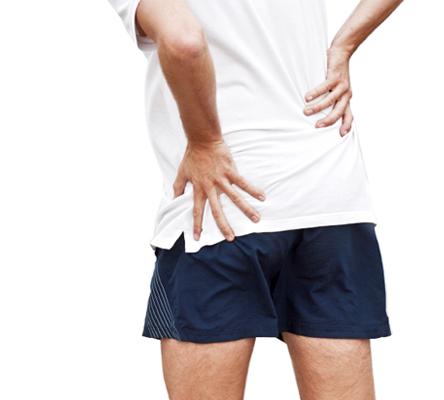
Definition
Trochanteric bursitis refers to inflammation of the trochanteric bursa causing pain in the hip.
The femur (thigh bone) has a bony process at the top of the bone known as the greater trochanter (figure 1). This bony prominence is a point of attachment of our gluteal muscles and is the outer most point of the hip. Between the gluteal muscles and the greater trochanter lies a bursa known as the trochanteric bursa (figure 1). A bursa is a small sac filled with lubricating fluid and is designed to reduce friction of the overlying soft tissue layers.
The gluteal muscles are primarily responsible for moving the hip and stabilizing the pelvis during activity and are particularly active during running, jumping, climbing stairs and squatting. During contraction of the gluteals, friction is placed on the trochanteric bursa. Pressure may also be placed on the trochanteric bursa following a direct impact. When these forces are excessive due to too much repetition or high force, irritation and inflammation of the bursa may occur. This condition is known as trochanteric bursitis.
- Patients with this condition typically experience pain in the outer aspect of the hip. Pain may also radiate down the outer aspect of the thigh as far as the knee. In less severe cases, patients may only experience an ache or stiffness in the hip.
- Aggravating activities include lying on that side (especially on hard surfaces), running, jumping, climbing stairs, sitting cross legged, getting in and out of the car or walking excessively (especially up hills or on uneven surfaces).
- The pain associated may ‘warm up’ with activity in the initial stages of injury. As the condition progresses, patients may experience symptoms that increase during sport or activity.
- Patients with trochanteric bursitis typically experience pain on firmly touching the trochanteric bursa (figure 1). Occasionally, a feeling of reduced strength may also be present particularly when attempting to climb stairs, perform a squat or accelerate whilst running.
Ignoring symptoms or adopting a ‘no pain, no gain’ attitude is likely to lead to the condition becoming chronic. Immediate, appropriate treatment in patients with trochanteric bursitis is essential to ensure a speedy recovery. Once the bursitis is chronic, healing slows significantly resulting in increased recovery times and an increased likelihood of future recurrence.
Initially, RICE in the first 72 hours following injury onset or when inflammatory signs are present. The RICE regime involves resting from aggravating activities, regular icing, and the use of a compression bandage (where possible) and keeping the affected leg elevated (i.e. lying on the opposite side).
Anti-inflammatory medication may also assist the healing process by reducing the pain and swelling associated with inflammation.
Physiotherapy treatment is vital to speed up the healing process, ensure an optimal outcome and reduce the likelihood of recurrence. Physiotherapy treatment may include:
- soft tissue massage
- electrotherapy (e.g. ultrasound)
- stretches
- ice or heat treatment
- exercises to improve strength, flexibility and core stability
- correction of abnormal biomechanics
- education
- anti-inflammatory advice
- activity modification advice
- a gradual return to activity program
Despite appropriate physiotherapy management, some patients with this condition do not improve adequately. The physiotherapist or doctor may then recommend further investigations. This is usually an ultrasound and must be arranged by the doctor. Less commonly, an X-ray, CT or MRI scan may be arranged. Corticosteroid injection may be recommended to help settle the inflammation. It is still imperative to complete a graduated flexibility and strengthening program after this injection.

